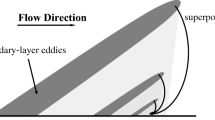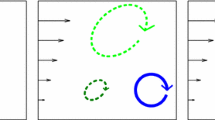Abstract
Transport by very weak turbulence near the surface, particularly with strong stratification, often violates existing similarity theory due partly to transient distortion of the wind profile by nonstationary mesoscale motions. This problem is examined with 4 months of flux data at seven levels on a 30-m tower. Difficulties with calculation of fluxes and shear with weak winds and weak turbulence are examined. The distortion of the wind profile assumes a wide variety of forms, but sometimes occurs with a transient wind maximum in the lowest 10 m. Though the vertical mixing of momentum is weak for weak-wind nonstationary conditions, it is often more efficient than predicted by existing similarity theory. In fact for weak-wind stable conditions, the flux-gradient relationship depends more on the curvature of the wind profile than the value of the stability parameter. This statistical study suggests a new direction for future work, but does not unravel the physics of the complex and varied structure for stratified weak-wind conditions.
Similar content being viewed by others
References
Abarbanel HDI, Holm DD, Marsden JE, Ratiu T (1984) Richardson number criterion for the nonlinear stability of three-dimensional stratified flow. Phys Rev Let 52: 2352–2355
Acevedo OC, Moraes OLL, Fitzjarrald D, Sakai R, Mahrt L (2007) Turbulent carbon exchange in very stable conditions. Boundary-Layer Meteorol 125: 49–61
Anfossi D, Oettl D, Degrazia G, Goulart A (2005) An analysis of sonic anemometer observations in low wind speed conditions. Boundary-Layer Meteorol 114: 179–203
Atlas D, Metcalf J, Richter JH, Gossard EE (1970) The birth of “CAT” and microscale turbulence. J Atmos Sci 27: 903–913
Balsley B, Frehlich R, Jensen M, Meillier Y, Muschinski A (2006) High-resolution in situ profiling through the stable boundary layer: examination of the SBL top in terms of minimum shear, maximum stratification, and turbulence decrease. J Atmos Sci 63: 1291–1307
Banta RM, Pichugina YL, Newsom RK (2003) Relationship between low-level jet properties and turbulence kinetic energy in the nocturnal stable boundary layer. J Atmos Sci 60: 2549–2555
Businger J (2005) Reflections on boundary-layer problems of the past 50 years. Boundary-Layer Meteorol 116: 149–159
Cava D, Giostra U, Siqueira M, Katul G (2004) Organized motion and radiative perturbations in the nocturnal canopy sublayer above an even-aged pine forest. Boundary-Layer Meteorol 112: 129–127
Derbyshire H (1995) Stable boundary layers: observations, models and variability Part II: data analysis and averaging effects. Boundary-Layer Meteorol 75: 1–24
Fernando HJS (2003) Turbulence patches in a stratified shear flow. Phys Fluids 656: 3164–3169
Grisogono B (1994) A curvature effect on the critical richardson number. Croatian Meteorol J 29: 43–46
Hiscox A, Nappo CJ, Miller DR (2006) Measuring nocturnal plume model dispersion parameters with Lidar. J Atmos Oceanic Tech 23: 1150–1154
Howell J, Mahrt L (1997) Multiresolution flux decomposition. Boundary-Layer Meteorol 83: 117–137
Mahrt L (2007) The influence of nonstationarity on the turbulent flux-gradient relationship for stable stratification. Boundary-Layer Meteorol 123: 245–264
Mahrt L, Howell J (1994) The influence of coherent structures and microfronts on scaling laws using global and local transforms. J Fluid Mech 260: 247–270
Mahrt L, Vickers D (2002) Contrasting vertical structures of nocturnal boundary layers. Boundary-Layer Meteorol 105: 351–363
Mahrt L, Vickers D (2005) Boundary-layer adjustment over small-scale changes of surface heat flux. Boundary-Layer Meteorol 116: 313–330
Nakai T, Molen M, Gash JHC, Kodama Y (2006) Correction of sonic anemometry angle of attack errors. Agric Forest Meteorol 136: 19–30
Nakamura R, Mahrt L (2005) A study of intermittent turbulence with CASES-99 tower measurements. Boundary-Layer Meteorol 114: 367–387
Nappo CJ (2002) An introduction to atmospheric gravity waves. Academic Press, Burlington MA USA, 297 pp
Newsom R, Banta R (2003) Shear-flow instability in the stable nocturnal boundary layer as observed by Doppler lidar during CASES99. J Atmos Sci 60: 16–33
Ohya J, Uchida T (2003) Turbulence structure of stable boundary layers with a near-linear temperature profile. Boundary-Layer Meteorol 108: 19–38
Pardyjak P, Monti P, Fernando H (2002) Flux Richardson number measurements in stable atmospheric shear flows. J Fluid Mech 449: 307–316
Skelly BT, Miller DR, Meyer TH (2002) Triple-hot-film anemometer performance in CASES-99 and a comparison to sonic anemometer measurements. Boundary-Layer Meteorol 105: 275–304
Smedman A-S, Högström U, Hunt JCR (2004) Effects of shear sheltering in a stable atmospheric boundary layer with strong shear. Quart J Roy Meteorol Soc 596: 31–50
van den Kroonenberg A, Bange J (2007) Turbulent flux calculation in the polar stable boundary layer:multiresolution flux decomposition andwavelet analysis. JGeophys Res 112: D06112, doi:10.1029/2006JD007819
Wiel BJH, Moene AF, Ronda RJ, De Bruin HAR, Holtslag AAM (2002) Intermittent turbulence in the stable boundary layer over land. Part II: a system dynamics approach. J Atmos Sci 59: 2567–2581
Vickers D, Mahrt L (2006) A solution for flux contamination by mesoscale motions with very weak turbulence. Boundary-Layer Meteorol 118: 431–447
Voronovich V, Kiely G (2007) On the gap in the spectra of surface-layer atmospheric turbulence. Boundary-Layer Meteorol 122: 67–83
Žagar N, Žagar M, Cedilnik J, Gregoric̆ G, Rakovec J (2006) Validation of mesoscale low-level winds obtained by dynamical downscaling of ERA40 over complex terrain. Tellus 58: 445–455
Author information
Authors and Affiliations
Corresponding author
Rights and permissions
About this article
Cite this article
Mahrt, L. The Influence of Transient Flow Distortion on Turbulence in Stable Weak-Wind Conditions. Boundary-Layer Meteorol 127, 1–16 (2008). https://doi.org/10.1007/s10546-007-9244-z
Received:
Accepted:
Published:
Issue Date:
DOI: https://doi.org/10.1007/s10546-007-9244-z




